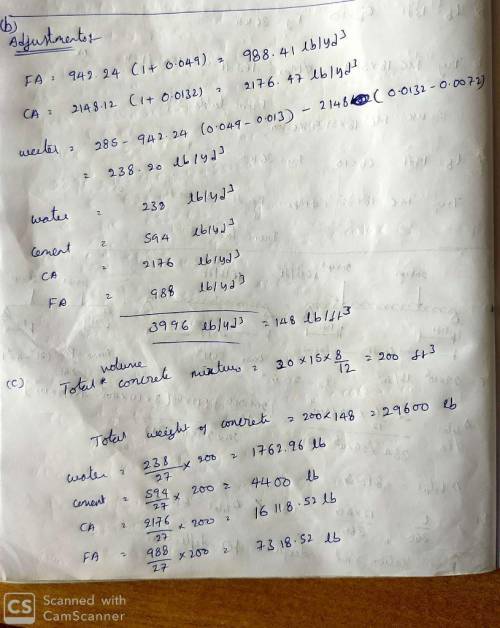
Engineering, 04.04.2020 11:32 DoyleAK108
Use the following information to complete the concrete mixture designs for the following question.
The following materials are available for a concrete mixture design:
ASTM C 150 Type I/II Cement
Relative density of 3.15
Coarse Aggregate: well-graded 3⁄4 in. maximum-size aggregate (MSA), crushed limestone, angular
Oven-dry specific gravity: 2.6
Absorption: 0.72%
Oven-dry rodded bulk density: 102 lb/ft3 Moisture content of coarse stockpile: 0.6%
Fine Aggregate: well-graded natural sand Oven-dry specific gravity: 2.5 Absorption: 1.3%
Moisture content of fine stockpile: 3.6% Fineness Modulus: 2.2
An air entraining admixture will provide enough air for the design mixture at a dosage rate of 3 oz/ft3
QUESTION:
Concrete is required for an 8 in thick exterior concrete slab in central Texas. A specified compressive strength, f’c , of 5000 psi is required at 28 days using an ASTM C 150 Type II portland cement. The design calls for a minimum of 2 in. of concrete cover over the reinforcing steel. The minimum distance between reinforcing bars is 3 in. A slump of 3 inches should be the target. The sidewalk is located in an environment that does not require air entraining. The concrete is required to have low permeability when exposed to water and moderate sulfates. The concrete will be exposed water soluble sulfates in soil at 0.14%. No statistical data on previous mixes are available.
Determine:
a. The theoretical mixture proportions of all concrete constituents (fine aggregate, coarse aggregate, water, cement, chemical admixtures) based on 1 yd3 of concrete on an oven dry basis for aggregates.
b. The as-batched mixture proportions based on the moisture contents provided in the materials available section.
c. How much of each material would be required to make a 20 ft long by 15 ft slab from the concrete mixture described above?

Answers: 3
Another question on Engineering

Engineering, 03.07.2019 15:10
Apiston-cylinder with a volume of 0.25 m3 holds 1 kg of air (r 0.287 k/kgk) at a temperature of 100 c. heat transfer to the cylinder causes an isothermal expansion of the piston until the volume triples. how much heat is added to the piston-cylinder?
Answers: 3

Engineering, 03.07.2019 15:10
Ahouse has the following electrical appliance usage (1) single 40w lamp used for 4 hours per day (2) single 60w fan used for 12 hours per day (3) single 200w refrigerator that runs 24 hours per day with compressor run 12 hours and off 12 hours find the solar power inverter size in watt with correction factor of 1.25.
Answers: 1

Engineering, 04.07.2019 18:10
An air conditioning system consist of a 5 cm diameter pipe, operating at a pressure of 200 kpa. the air initially enters the pipe at 15°c with a velocity of 20 m/s and relative humidity of 80%. if the heat supply throughout the process is 960 w, determine the relative humidity and the temperature at the outlet
Answers: 3

Engineering, 04.07.2019 18:10
Which from the following instrument is commonly used to detect the high pitch butzing sound in bearings? [clo4] a)-digital ultrasonic meter b)-infrared camera c)-spectroscopic d)-vibrometer
Answers: 2
You know the right answer?
Use the following information to complete the concrete mixture designs for the following question.
Questions

History, 13.05.2021 06:00

Mathematics, 13.05.2021 06:00

Mathematics, 13.05.2021 06:00

World Languages, 13.05.2021 06:00




Mathematics, 13.05.2021 06:10

Mathematics, 13.05.2021 06:10

Computers and Technology, 13.05.2021 06:10

Mathematics, 13.05.2021 06:10

Spanish, 13.05.2021 06:10


Geography, 13.05.2021 06:10

Spanish, 13.05.2021 06:10


English, 13.05.2021 06:10

English, 13.05.2021 06:10






